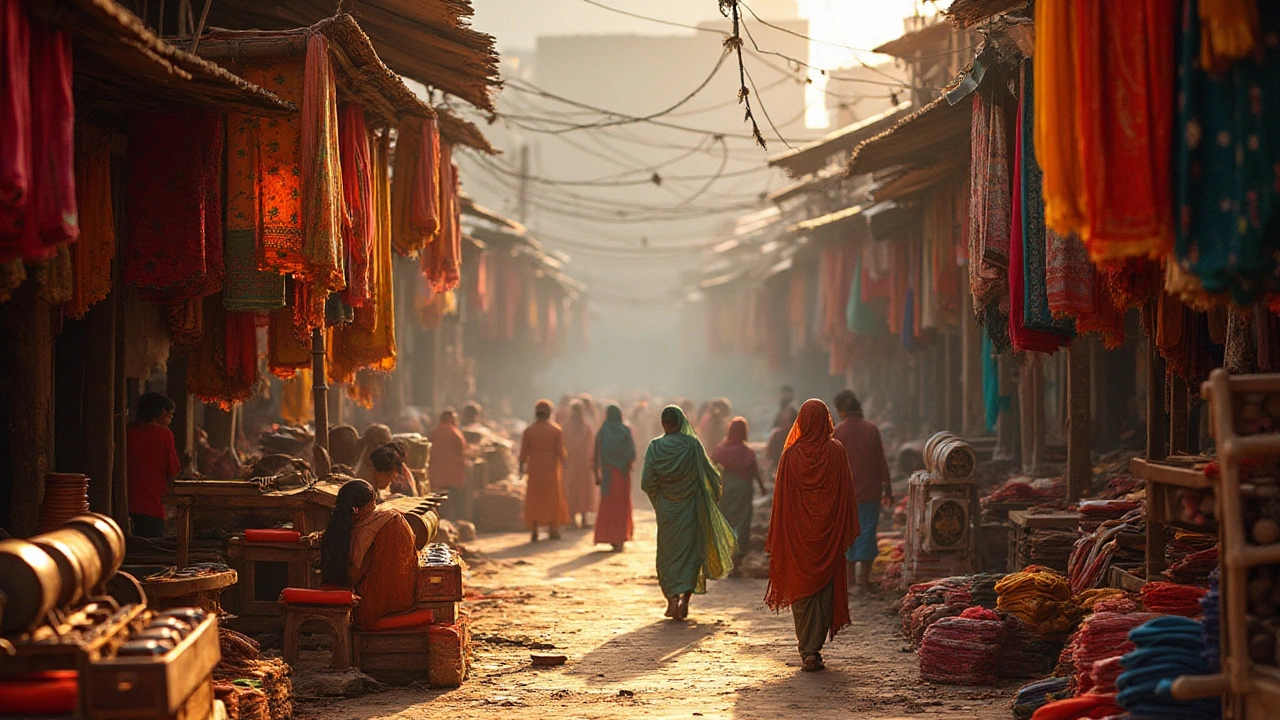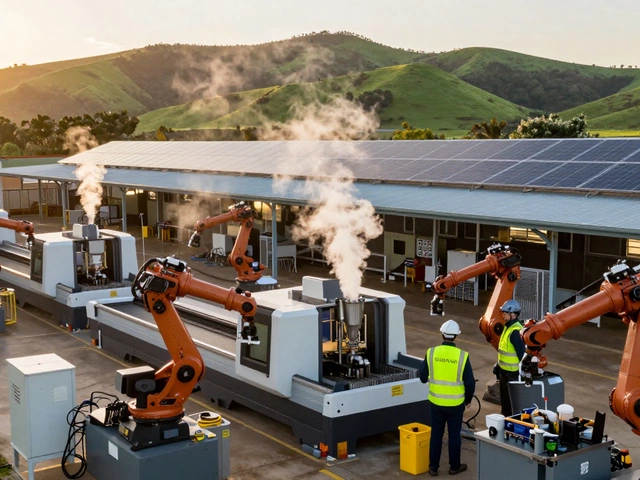Current Trends and Challenges in India's Textile Industry

The textile industry in India, deeply interwoven with the nation's socio-economic fabric, remains a formidable force in the global market. Its roots run deep, with a history that stretches back for centuries, reflecting a rich tradition of craftsmanship and innovation. Today, as we assess its current state post-2023, we find an industry at a crossroads of technology and tradition.
This sector is not only vital to the Indian economy, contributing significantly to employment and exports, but it is also a key player in the global textile arena. However, like many industries worldwide, it grapples with challenges that include environmental impacts and intense international competition. Navigating these waters requires insight into both cutting-edge manufacturing techniques and sustainability efforts, ensuring growth that respects both people and the planet.
Join us as we explore the vibrant canvas of India's textile industry, understanding its current trends, evaluating its challenges, and contemplating its future direction.
- Historical Significance and Economic Impact
- Modern Manufacturing Techniques and Innovations
- Challenges Facing the Industry
- Future Prospects and Sustainability
Historical Significance and Economic Impact
India's textile industry is a rich tapestry that not only narrates stories of its past but also threads its economic fabric today. For centuries, India's textiles have captivated the world, with the renowned muslins of Dhaka, the silk of Banaras, and the handcrafted patterns of Kanchipuram. The indigo dye and the famed cotton trade routes put ancient India on the global map, linking it via the Silk Road and maritime adventures to distant markets.
The dawn of the industrial age saw India transform into a manufacturing powerhouse. By the 19th century, with the opening of several cotton mills, the textile sector burgeoned, breathing new life into India's economy. Despite colonial setbacks where raw materials were exported for processing abroad, Indian textiles remained a symbol of resistance and self-reliance during the struggle for independence. Fast forward to today, this industry provides employment to over 45 million people, highlighting its role as the second-largest provider of jobs in India, just after agriculture.
Economically, the textile sector is a cornerstone, contributing approximately 2.3% to the country's GDP and accounting for around 13% of industrial production. It's remarkable to note that the export market earns nearly 27% from textiles, making it crucial to India’s foreign exchange reserves. This vast industry encompasses a variety of segments, from traditional handloom and handicrafts to organized sectors, which include spinning, weaving, processing, and apparel production.
"The textile industry of India holds a pivotal position in the economic landscape, bridging the traditional and the modern," says economist Arvind Sinha, emphasizing the sector's dual role in cultural preservation and modernization.
To appreciate the true scale, consider the consumption driven by India's massive domestic market. With a growing population, there is a sustained rise in demand for garments and home textiles. This demand fuels a dynamic market, with increasing innovations in fabric blends and designs tailored to modern needs. A closer look at state-wise contributions reveals a diverse ecosystem, with states like Tamil Nadu, Maharashtra, and Gujarat leading in cotton production, while Punjab remains dominant in wool. Each region showcases unique strengths, from raw materials to finished products.
Even as the textile sector rides the wave of economic liberalization, challenges remain on the horizon. Balancing traditional practices with modern sustainable techniques is imperative. As the world pivots towards more eco-friendly practices, the industry must adapt to stricter environmental regulations. Continued investment in technology and infrastructure is crucial to maintain its pivotal role. These efforts can propel India to even greater heights, strengthening its status as a textile titan in an ever-evolving global market.

Modern Manufacturing Techniques and Innovations
The advancement of modern manufacturing techniques in India's textile industry has significantly transformed the sector, bringing about a more efficient, sustainable, and competitive production process. One of the remarkable innovations is the adoption of automated machinery, which has redefined the textile manufacturing landscape. These machines, capable of performing complex tasks such as weaving, dyeing, and printing with precision, have immensely cut down production times and minimized human error. This introduction of automation aligns well with the global shift towards Industry 4.0, where connectivity and smart operations enhance productivity.
In parallel, digital textile printing is gaining momentum in the industry, offering unprecedented flexibility in design and production. This technique allows for vivid and intricate designs, making it a favorite among designers and manufacturers who need to cater to the ever-changing fashion trends. Besides, it reduces wastage, as it uses only the necessary amount of ink, supporting the industry's sustainability goals. A report by Technavio highlights that the digital textile printing market in India is expected to grow by over 4% annually, showcasing its rising significance.
"Digital printing is not just a trend but a necessity for textile manufacturers aiming for bespoke designs and faster lead times," remarks Naveen Gupta, a prominent textile expert.With sustainability becoming a pivotal aspect of modern manufacturing, eco-friendly dyes and organic materials are being prioritized significantly. The push for sustainable practices is not only due to regulatory pressures but also an increasing consumer demand for eco-friendly products. This paradigm shift is encouraging manufacturers to develop biodegradable fabrics, thus enhancing the brand's market appeal and reducing environmental footprints.
Innovations in textiles aren't solely dependent on machinery and materials; they also extend to technical textiles, which cater to specialized applications in industries such as healthcare, automotive, and defence. These textiles are engineered for specific functions and have seen a notable increase in demand due to their exceptional properties, such as fire resistance, antibacterial features, and enhanced durability. Reflecting on this, the technical textile segment in India is projected to grow at a robust rate, supported by government initiatives like the National Technical Textiles Mission, aiming to position India as a global player in this niche segment.
Let's not overlook the role of sustainability certifications and international standards in pushing manufacturers towards greener practices. Strict adherence to these standards is gradually becoming a prerequisite for entry into international markets, thus driving innovations. This evolving landscape ensures that Indian textile manufacturers not only compete but lead on the world stage, presenting a bright future for the industry's technological advancements.

Challenges Facing the Industry
The textile industry in India encounters a variety of challenges that impact its growth and sustainable development. One of the major issues is the intense competition from other countries, particularly those in Southeast Asia and China. These regions have increasingly competitive prices, attractive incentives, and rapid advancements in technology, making it difficult for Indian textiles to maintain their edge in the international market.
Environmental concerns present another formidable challenge. The textile sector is often criticized for its pollution and environmental footprint. Traditional dyeing processes, for instance, release large quantities of untreated liquid waste into water bodies, affecting aquatic life and contaminating water sources. The industry is under significant pressure to adopt more sustainable practices while ensuring these changes do not compromise economic viability.
Moreover, many manufacturers rely on outdated technologies that hinder efficiency and innovation. The lack of investment in modern machinery and processes can slow down the textile manufacturing capabilities, hindering the ability of companies to meet the fast-paced demands of global fashion trends. Embracing automation and innovation is necessary but often constrained by high costs and the technical skills gap.
Trade policies and tariffs continue to pose significant challenges as well. Fluctuating trade agreements and the imposition of tariffs can affect the ease of exporting textiles, particularly to key markets like Europe and North America. The uncertainty surrounding these economic policies can stall investment and harm long-term growth prospects.
Labor issues also come into play significantly in this sector. Despite being a major employment provider, the textile industry faces labor unrest due to poor working conditions and low wages. Improving labor standards and ensuring compliance with international labor laws are imperative concerns that need addressing for sustainable development. In fact, according to the International Labour Organization (
The textile sector must prioritize fair labor practices to ensure the safety and welfare of its workforce, which is indispensable for its growth.)
- International Labour Organization
Finally, supply chain disruptions, whether due to pandemics, geopolitical tensions, or logistics issues, present real risks. The COVID-19 pandemic, for example, underscored vulnerabilities in global supply chains, leading to delayed shipments and contract cancellations. Mitigating such risks requires building resilient and adaptable supply chains that can withstand such unforeseen circumstances.

Future Prospects and Sustainability
The future of the textile sector in India teeters on the edge of promising potential and significant responsibility. As this vibrant industry gears up to align itself with global expectations, both in terms of quality and ethical responsibility, innovation becomes its cornerstone. Companies are increasingly focusing on integrating sustainability into their core operations, understanding that long-term success hinges not just on productivity and profits but also on the health of the planet. This emphasis on eco-friendly methods is reshaping aspects such as resource utilization, supply chain efficiency, and waste management.
A modern gaze at the industry reveals that many Indian textile manufacturers are investing in cutting-edge technologies. Automation and AI are rapidly transforming production lines, making them more efficient and less reliant on manual labor, which reduces errors and enhances consistency. In parallel, the rise of 'green' processes, which leverage natural dyes and biodegradable materials, aligns with global trends that demand eco-conscious products. These advancements aren't born in isolation, however. They emerge from a robust dialogue with international buyers who prize sustainable practices and seek transparent collaborations.
"Sustainability is not a trend; it's the industry's future," says Pradeep Kumar, a renowned expert in sustainable textiles. His insights underscore the inevitable shift toward processes that prioritize minimal environmental impact while maximizing productivity.
Today, the growth trajectory of the textile industry intersects significantly with governmental policies aimed at fostering a greener economy. Policies incentivizing solar-powered textile mills or tax breaks for companies using recycled materials propel the industry forward. It isn't only about reducing carbon footprints but also about ensuring the industry remains a viable source of employment. The Indian government, aware of this potential, actively supports businesses transitioning to sustainable methods, a critical maneuver that may safeguard millions of jobs.
Looking ahead, the industry's capacity to innovate while maintaining its cultural identity could be its most significant strength. This balance is crucial as consumers worldwide increasingly demand ethical and sustainable products. Key to meeting such demands is the ability to adapt the rich tapestry of traditional Indian craftsmanship to modern sustainable practices. Brands that can weave together the past and the present, leveraging ancient techniques with new-age sustainability, may find themselves at the forefront of a revolution in Indian textiles. The industry's continued collaboration with global partners will be pivotal, facilitating shared learning and the spread of best practices.
Another dimension shaping the future is circular fashion, which advocates for creating clothes with lifecycles that extend well beyond their initial use. Herein lies a tremendous opportunity for Indian textiles to lead by example by developing durable products that can be upcycled or completely recycled. Consumers are progressively aligning with brands that embrace circularity, shaking up the entire production spectrum from fabric choice to garment design.


